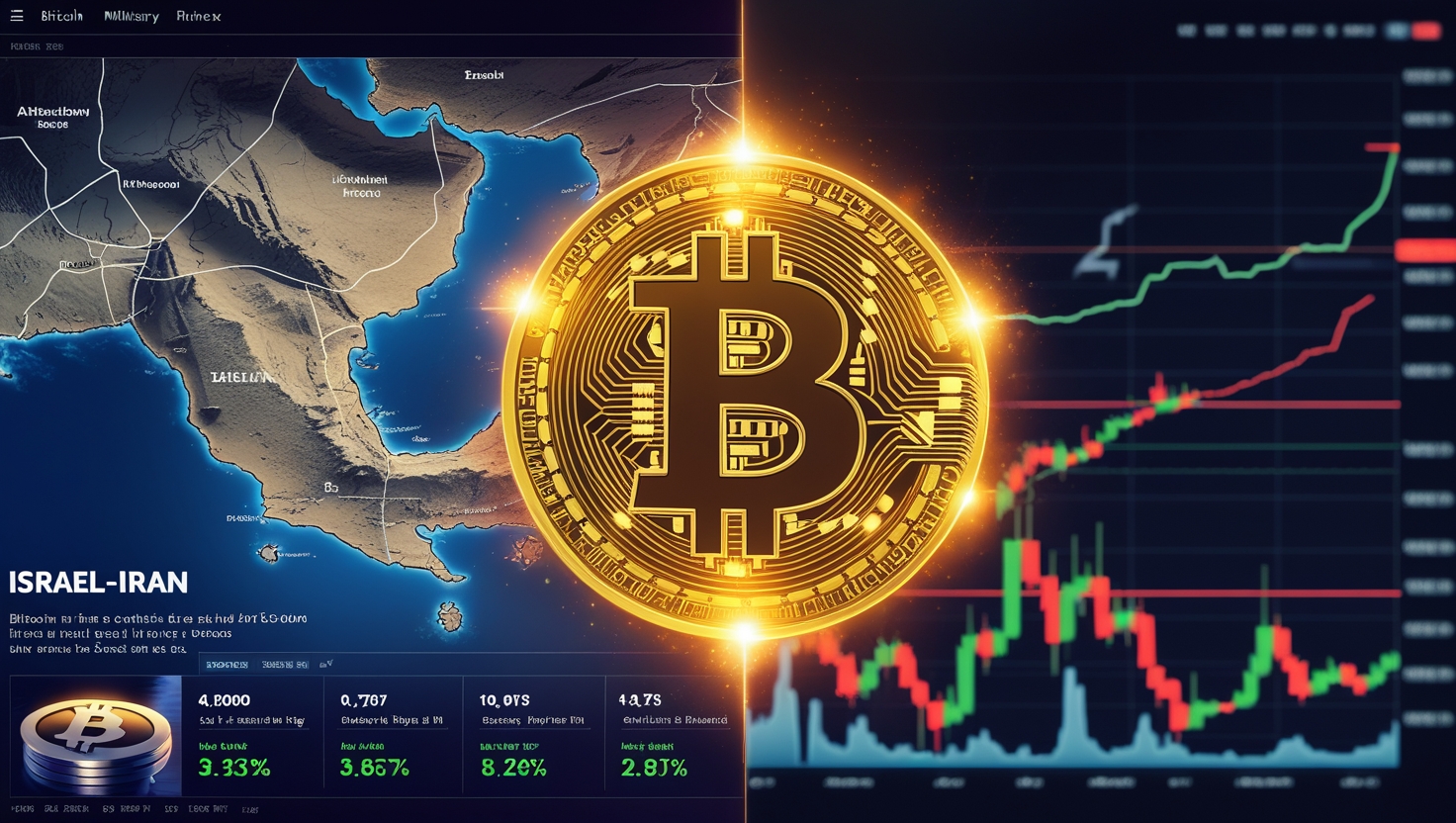The escalating Israel-Iran conflict has sent shockwaves through global financial markets, and cryptocurrency isn’t immune. While Bitcoin fights to stay above $100,000, altcoins are crumbling under geopolitical pressure. The much-anticipated altcoin season? It’s officially on pause.
Here’s what crypto investors need to know about how Middle East tensions are reshaping the digital asset landscape and why Bitcoin dominance is surging while altcoins struggle to keep pace.
Flight to Safety: Bitcoin Surges as Altcoins Struggle
When geopolitical tensions flare, investors flee to safety. The Israel-Iran conflict has triggered exactly this response in crypto markets, with Bitcoin emerging as the clear winner.
Since June 13, when Israel launched a major operation against Iran, Bitcoin’s market dominance has climbed steadily. It now sits at 65.30%, up nearly 1% since the initial strike. This isn’t just a number—it represents billions of dollars flowing out of altcoins and into Bitcoin.
The data tells a stark story. While Bitcoin maintains its position above psychological support levels, Ethereum and other altcoins are lagging significantly. The ETH/BTC ratio has declined throughout this period, signaling that even the second-largest cryptocurrency can’t match Bitcoin’s safe-haven appeal during times of uncertainty.
This flight to safety isn’t unique to crypto. Traditional markets have long seen investors rotate into gold and Treasury bonds during global conflicts. Now, Bitcoin is joining this exclusive club of crisis-resistant assets.
The Data Speaks: Capital Rotation to Bitcoin
Market data reveals the full extent of capital rotation happening beneath the surface. The altcoin market cap, excluding the top 10 coins, has dropped to $230.08 billion during the conflict period.
Agne Linge, Head of Growth at WeFi, confirms what the charts are showing. “Typically, during global conflicts that affect political and macroeconomic stability, investors tend to shift their capital from risky assets to those perceived as safe havens,” Linge explained in an exclusive interview. “It used to be gold and Treasuries; however, we can now see that Bitcoin is also acting as a digital safe haven.”
The numbers back up this assessment. The “OTHERS” metric, which tracks altcoin market share outside the top 10, has shed $12 billion in just ten days. This massive outflow represents traders rotating their capital allocation from altcoins to safer assets like Bitcoin and stablecoins.
“The altcoin market cap, excluding the top 10 coins, dropped immediately when the conflict started escalating,” Linge noted. “That means that the traders were rotating their capital allocation from altcoins to safer haven coins such as Bitcoin and stablecoins.”
This capital rotation explains why Bitcoin dominance continues climbing even when BTC’s own price action remains relatively muted. Investors aren’t necessarily bullish on crypto overall—they’re seeking the safest harbor in a storm.
Bitcoin Dominance and ETH/BTC Ratios Tell the Real Story
Two key metrics confirm the trend toward Bitcoin supremacy during this geopolitical crisis: Bitcoin dominance (BTC.D) and the ETH/BTC ratio.
Bitcoin dominance hit a multi-year high of 65.95% on Sunday before pulling back slightly to current levels around 65.30%. This metric measures Bitcoin’s market cap relative to the entire cryptocurrency market, and its rise indicates money flowing out of altcoins and into BTC.
“BTC.D indicates Bitcoin dominance versus altcoins, and it has been rising since the conflict began,” Linge confirmed. This rising dominance during a period of global uncertainty mirrors patterns seen in traditional safe-haven assets during previous geopolitical crises.
The ETH/BTC ratio provides another crucial data point. This ratio measures Ethereum’s performance relative to Bitcoin, and its decline since June 16 shows that even the leading altcoin platform is losing ground to BTC.
“ETH/BTC ratio is also an important indicator, since the majority of altcoins are based on the Ethereum blockchain, and the rising ratio means that Ethereum is outperforming BTC,” Linge explained. “The ratio has fallen since June 16 and has remained stagnant.”
Since many altcoins are built on Ethereum or follow its price patterns, ETH’s underperformance against Bitcoin signals broader weakness across the altcoin sector. When Ethereum can’t keep pace with Bitcoin, smaller altcoins face even greater challenges.
Altcoin Season Index: Why It’s Still Bitcoin’s Time
The Altcoin Season Index provides the clearest picture of just how far we are from a true altcoin rally. This metric, tracked by Blockchain Center, measures what percentage of the top 50 altcoins are outperforming Bitcoin over a 90-day period.
For altcoin season to officially begin, at least 75% of these coins need to outperform BTC. Currently, only 16% have managed to do so over the past 90 days. This massive gap shows that despite hopes for an altcoin breakout, the market remains firmly in Bitcoin’s grip.
The timing couldn’t be more telling. Just as many crypto analysts were predicting the start of altcoin season—that magical period when smaller cryptocurrencies dramatically outperform Bitcoin—geopolitical tensions have effectively put those plans on ice.
The low percentage of altcoins outperforming Bitcoin isn’t just about the Israel-Iran conflict, though the timing is significant. It reflects a broader risk-off sentiment that makes investors hesitant to venture beyond the relative safety of Bitcoin and established cryptocurrencies.
This data suggests that any true altcoin season will need to wait for geopolitical tensions to subside and investor confidence to return to risk assets.
Impact of Israel Iran War on Crypto Investments
The ongoing conflict demonstrates how geopolitical risks affecting altcoin performance extend beyond traditional financial markets. Cryptocurrency markets, once thought to be somewhat insulated from global political events, are showing clear sensitivity to international tensions.
The crypto market reaction to Middle East tensions follows predictable patterns seen in other asset classes. When uncertainty rises, investors consolidate into assets they perceive as most likely to preserve value. In crypto, that means Bitcoin.
This shift has important implications for portfolio allocation. Crypto investors who were heavily weighted toward altcoins have seen their holdings underperform significantly during this period. Meanwhile, those with larger Bitcoin allocations have experienced relative stability.
The conflict also highlights Bitcoin’s evolving role as a safe haven cryptocurrency during war. While Bitcoin has experienced volatility throughout its history, its performance during this specific geopolitical crisis suggests it’s maturing as a store of value asset.
Understanding why Bitcoin outperforms altcoins during conflict requires recognizing the psychology behind safe-haven investing. When fear dominates markets, investors gravitate toward the most liquid, established, and widely recognized assets in any given category. In cryptocurrency, that’s clearly Bitcoin.
Waiting for Calmer Seas
The Israel-Iran conflict has fundamentally altered crypto market dynamics, at least temporarily. Bitcoin dominance at 65.30%, declining altcoin market caps, and dismal readings from the Altcoin Season Index all point to the same conclusion: this isn’t altcoin season’s time.
The data reveals a clear pattern of capital flight from riskier altcoins toward Bitcoin and stablecoins as geopolitical uncertainty persists. Only 16% of top altcoins are outperforming Bitcoin over the past 90 days—far from the 75% threshold needed for true altcoin season.
This doesn’t mean altcoin season is canceled forever. Historical patterns suggest that once geopolitical tensions subside and investor confidence returns, capital may flow back into higher-risk, higher-reward altcoin investments. The question isn’t whether altcoin season will eventually arrive, but when global stability will create the right conditions for it to flourish.
For now, the conflict continues to reinforce Bitcoin’s position as the digital safe haven of choice. Until peace returns to the Middle East, altcoin investors may need to exercise patience as their preferred assets remain under pressure from ongoing global political instability.

